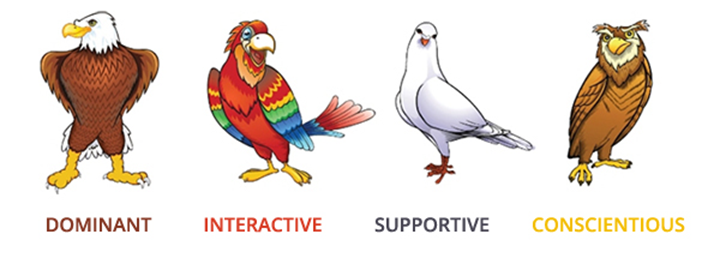
Twenty-four hundred years ago, scientists and philosophers, most notably Hippocrates, began to recognize and categorize differences in behavior that seemed to follow a pattern.
Since then, many psychologists and scientists have explored behavioral patterns.
Dr. William Marston wrote “The Emotions of Normal People” in 1928 after earning his doctorate from Harvard University.
Marston theorized that people are motivated by four intrinsic drives that direct behavioral patterns.
He used four descriptive characteristics, Dominance, Influential, Steadiness, and Compliance, for behavioral tendencies, represented by four letters of the alphabet: D, I, S, and C. Thus, the concept of “DISC” was introduced.
To use the DISC model effectively, remember that nothing in the DISC model describes or discusses any psychosis, mental illness, or psychological abnormality.
Instead, the DISC model describes human behavior as defined by two key motivators, the Motor Drive (or Pace Drive) and the Compass Drive (or Priority Drive).
Motor/Pace Drive
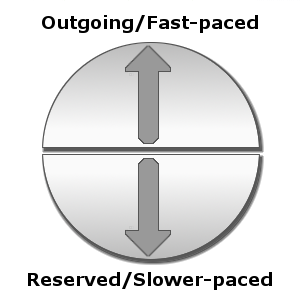
The lower half represents reserved or slower-paced people.
Outgoing people tend to move fast, talk fast, and decide quickly.
Reserved people tend to speak more slowly and softly than outgoing people and generally prefer to consider things carefully and thoroughly before deciding.
Remember that these descriptions of behaviors are tendencies rather than absolutes.
The shading of the circle from lighter to darker indicates varying intensities of these drives as you move from the center to the ends.
Close to the middle of the circle would represent less intensity in the motor activity, and we use lighter shading towards the center.
Moving towards the outer edge of the circle represents higher intensity in the motor drive, and we use darker shading.
A person’s perspectives and behaviors could lie anywhere along this line.
Most people will exhibit a bit of both of these traits depending on the situation they find themselves in.
Even though this is usually true, most people exhibit more of one trait or the other – even if it is slightly more.
Compass/Priority Drive
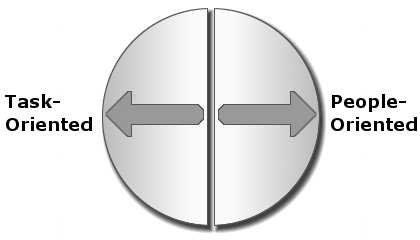
The left half represents task-oriented people.
The right half represents people-oriented people.
Task-oriented people focus on logic, data, results, and projects.
People-oriented people tend to focus on experiences, feelings, relationships, and interactions with other people.
Just as with the Motor drive diagram, the shading of the arrows from lighter to darker indicates varying intensities of the Compass drive.
Close to the midline shows less intensity in the Compass drive, therefore light shading.
Towards the outer edge shows more intensity in the Compass drive, therefore darker shading.
Four Basic DISC Styles or Types
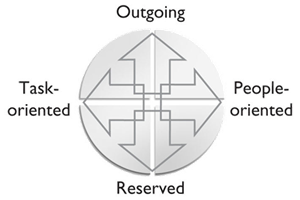
Sometimes called the DISC circle, the diagram below represents the full graphical description of what is commonly referred to as The DISC Model of Human Behavior.
Notice that each quadrant of the DISC circle has descriptive words attached to it.
These descriptive words attempt to capture the typical behavior traits or tendencies people exhibit with the combination of motor and compass drives corresponding to that quadrant.
They are often called a behavioral type or style to make discussing the quadrants easier.
While it is not strictly or technically accurate from a clinical psychology standpoint to use the phrase personality type with this model, it is often used in everyday conversation.
Behavioral style is preferred because it accurately fits the model and its theoretical basis.
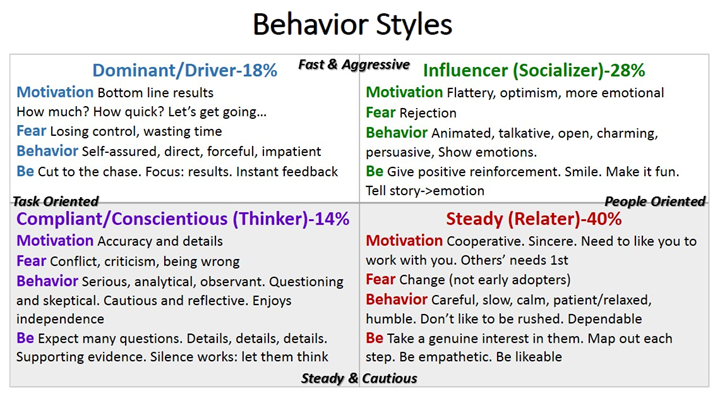
The Sixteen Common Styles
Beyond the Four Core Styles,
there are Sixteen Styles based on the patterns of High and Low Core Styles:
The Achiever is High in Dominance and Steadiness in either order or High Dominance with Steadiness and Compliance in that order.
The Agent is High in Steadiness followed by high in Compliance and Influence in either order.The Appraiser is High in Influence and Compliance in either order.
The Counselor is High in Influence and Steadiness in either order.
The Creator is High in Dominance and Compliance in either order or High in Dominance followed by high Compliance and Steadiness in that order.
The Developer is High in Dominance.
The Practitioner is High in Compliance, Steadiness, and Influence in any order.
The Promoter is High in Influence.
The Creator is High in Dominance and Compliance in either order or High in Dominance followed by high Compliance and Steadiness in that order.
The Developer is High in Dominance.
The Inspirational is High in Dominance and equally high in Influence.
The Investigator is High in Steadiness followed by high in Dominance and Compliance in either order.
The Perfectionist is High in Compliance and Steadiness in either order.
The Persuader is High in Influence followed by high in Dominance.The Practitioner is High in Compliance, Steadiness, and Influence in any order.
The Promoter is High in Influence.
The Result-Oriented is High in Dominance followed by high Influence.
The Specialist is High in Steadiness.
The Stress Pattern all are in the mid-point.
The Thinker is High in Compliance.Behavior to MBTI mapping
| MBTI Dominant Function | Dominance and Influence Internal Locus of Control | Compliance and Steadiness External Locus of Control |
| Ne | Share ideas freely | Generate discussion with others during brainstorming to affirm their ideas |
| Demonstrate confidence in offering ideas to others | Use predictable and consistent ways to help others understand | |
| Take risks with unique opportunities | Share ideas in an accurate and precise manner | |
| Can establish buy-in for less conventional ideas | Show loyalty to others by promoting harmony | |
| Ni | Are confident in the integrity of their ideas even without buy-in | Take time to establish competence before sharing learnings |
| Can establish a plan with less external feedback | Rally for support behind the scenes | |
| Base ideas and hypotheses on intuitive logic | Look for more affirmation from others before sharing ideas | |
| Firmly believe that their idea will work | Are less verbally confrontational if or when ideas are challenged | |
| Se | Insist that facts be final and accurate | May seem insecure when facts are challenged |
| Don't need others to confirm their findings | May become frustrated when standards are not upheld | |
| Will be tenacious about proving what is right and wrong | We will strive to provide absolute accuracy and quality | |
| May overwhelm others with information that holds less relevance | Create step-by-step analysis to prove quality and gain buy-in | |
| Si | They may not always share the rationale of their ideas with others | Are cautious about jumping into arguments unless sure of facts |
| May resist change for change's sake (in a stubborn way) | They may have to push themselves to collaborate with others | |
| Provide service to others through the use of details | Become anxious when others disagree with their facts | |
| Are solid in their conviction about the steps necessary for success | Are good at spotting flaws that interfere with the implementation of a plan | |
| Te | Are persuasive and competitive in striving for the best | Pride themselves on their analytical thinking ability |
| Seek power in influencing others with ideas | Become frustrated when performance standards are not clearly defined | |
| Provide fast-paced idea generation | Feel that consistency and competency are key to approval from others | |
| Are logical and democratic in an autonomous way | Need feedback about ideas and credit for accomplishments | |
| Ti | Blossom in one-on-one discussions of strategy and vision | Take a more reserved and businesslike approach to the team process |
| Motivate others through a commitment to objectivity | May not always share questions/challenges with others | |
| Want freedom from overprocessing details | Are patient in hearing and listening to other people's ideas | |
| Appeal to what makes sense to others through logic | I wouldn't say I like being caught off guard | |
| Fe | Connect with others by entertaining them | Seek to be recognized for cooperating with others |
| Infect others with their enthusiasm | Take pride in accommodating others' needs | |
| Focus on helping others achieve their individual or group goals | Are loyal to others and good listeners | |
| They may not need social recognition as much as Thinking types, but they still receive it | Like clearly defined expectations so they will not disappoint others | |
| Fi | Are solid in their values and convictions about right and wrong | May be reluctant to disagree with an idea if a conflict will follow |
| Make decisions to benefit others | Strive to cooperate with others behind the scenes to make things happen | |
| Connect more comfortably one-on-one or in small groups | Dislike taking risks that involve hurting another person's feelings | |
| Motivate others by setting a good example | Systematically apply benefits of service to people to the bottom line |